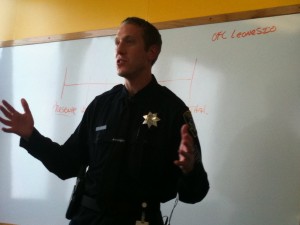During his session Hubbard explained that force has three purposes: to protect life, to enforce the law within its limits, and to overcome resistance so officers can make an arrest. As policies change it's up to the department to ensure that the guidelines are obeyed by hundreds of officers on many different beats. Those who don't comply face re-training and possible disciplinary action, while OPD leadership reviews its policies again for what could have been done differently.
Quan sat in on part of the workshop, asking questions from the back of the room. Use-of-Force is just one of several OPD-related challenges she'll take on when she officially becomes Mayor. Staffing levels are another; without funding for more officers the workforce is stretched thin, leaving officers little time for training. The department continues to review its policies in the wake of a federal Negotiated Settlement Agreement, brought after the Riders police corruption scandal in July 2000. The agreement expired this year, replaced by a two-year Memorandum of Understanding.
"Our goal is to be a police department that's not under a federal consent decree," Quan said, "a police department that the community and citizens, and the government, and the officers themselves, can feel confident in."
The sometimes tense relationship between law enforcement and some Oakland residents heated up again last month when Oakland officers shot Derrick Jones, owner of a local barber shop, after he ran from the officers. According to the department, Jones was shot after he reached for something metallic in his waistband. It turned out to be a scale used for weighing marijuana. A community group protested the shooting during this week's Oakland City Council meeting, disrupting the proceedings.
Sgt. Hubbard says OPD is updating its training for officers regarding Use-Of-Force. The old way of thinking said that you start with the least lethal means at your disposal, including talking to a subject or just appearing on a scene, in hopes of settling things. Then, if that doesn't work, you use ever-more-serious means as appropriate. The new paradigm, called Force Options, relies more on officers' discretion to use whatever means is reasonable for that particular situation, based on the subjects, their actions and the surroundings.
If this sounds incredibly difficult to teach, Hubbard says, it surely is.
"'Oh, this makes total sense!'" Hubbard says, recalling trainees who find the techniques a breeze in the classroom. "'Oh, yeah, this is easy!' The application (of these policies)? Totally different."
Oakland PD puts officers through 120 hours of training on Use-Of-Force: 40 hours more than the state requires. A hiring freeze means there are no new trainees, but current officers receive 24 hours of defensive tactics and firearms training every year, ensuring they not only can shoot straight, but can discern what and if they should shoot at all.
ON TUESDAY: Can an officer legally shoot a suspect in the back? Inside OPD's Use-of-Force simulator
